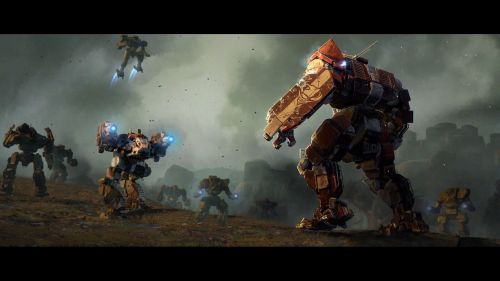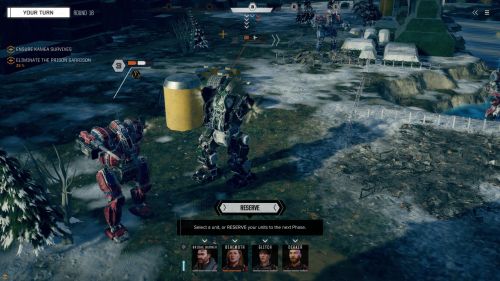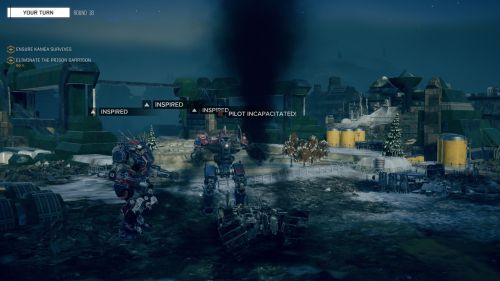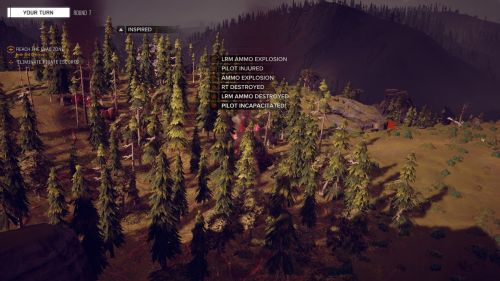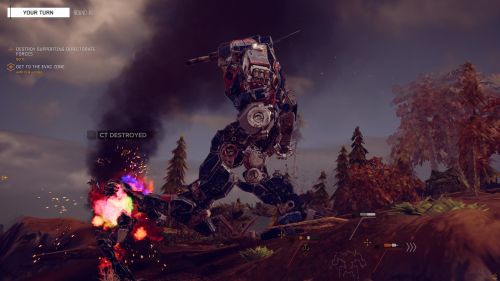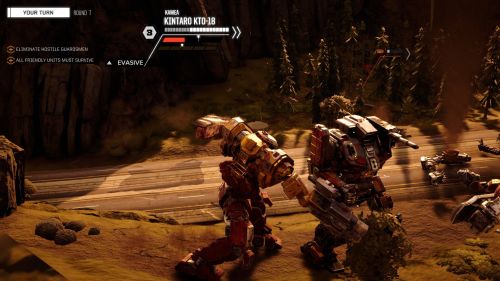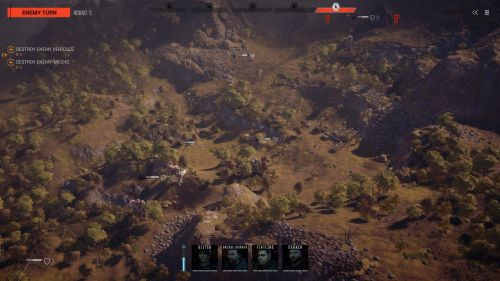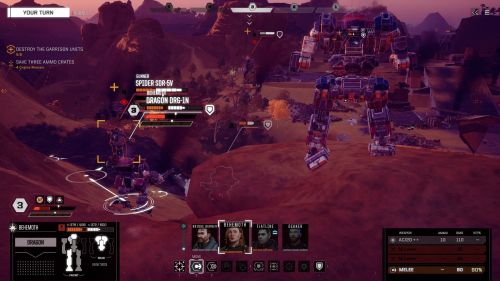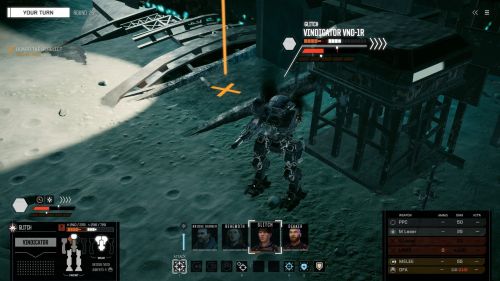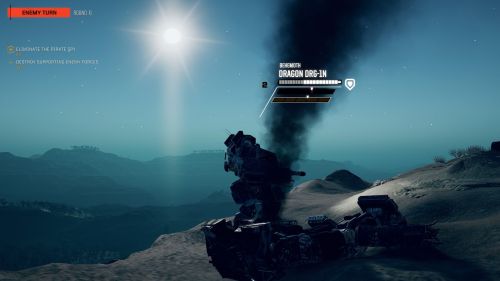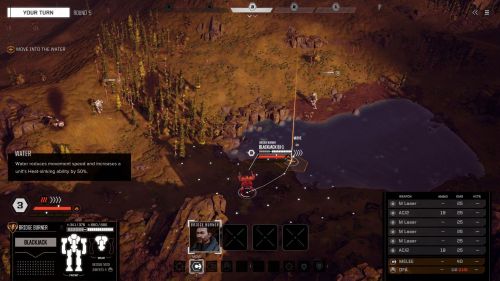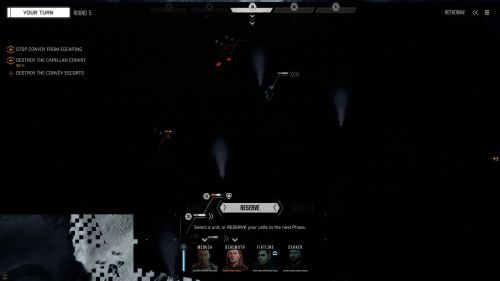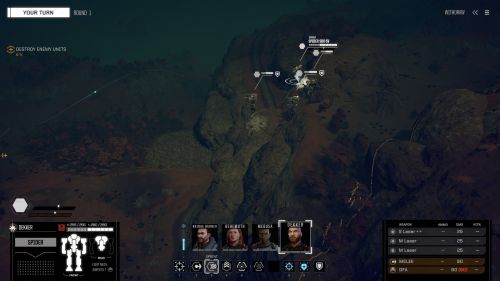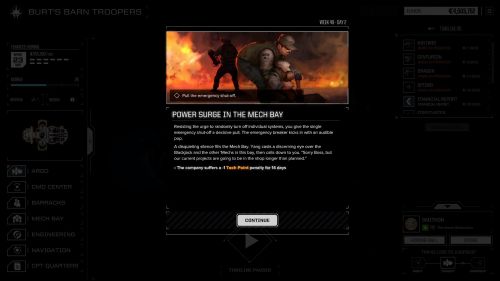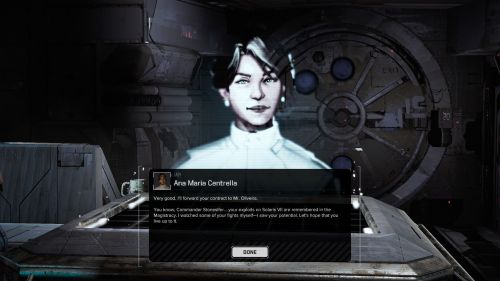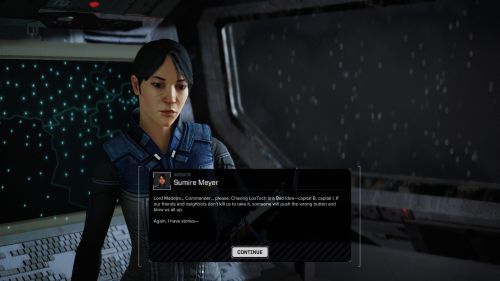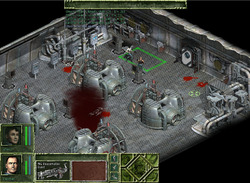RPG Codex Review: BATTLETECH
RPG Codex Review: BATTLETECH
Codex Review - posted by Infinitron on Sat 16 June 2018, 15:10:43
Tags: BattleTech; Harebrained SchemesHarebrained Schemes' 2013-2015 trilogy of Shadowrun roleplaying games weren't known for their awesome gameplay but were lauded for their writing, establishing the Seattle-based studio's reputation as a narrative powerhouse. The second game in the trilogy, Shadowrun: Dragonfall, was particularly popular on our forums - rivaling the far more mechanically robust Divinity: Original Sin for the title of our 2014 GOTY largely due to the merits of its narrative design. Commercially, however, this storytelling excellence was not enough to make the Shadowrun RPGs anything more than budget-priced minor hits.
With BattleTech, Harebrained set out to expand beyond their core competency. With its more robust tactical combat implementation and strategic mercenary company management layer, contextualized by the rich lore of the BattleTech universe, the game sought a more even balance of story and gameplay. From a commercial perspective, this approach has clearly been a resounding success for the studio, with hundreds of thousands of copies sold and a handsome $7.5M buyout by publisher Paradox Interactive. But has this shift in priorities led to a more satisfying game, or have we gone from excellent narrative and perfunctory gameplay to tedious mediocrity on both fronts?
The man to answer that question is our esteemed tactical specialist sser, who volunteered to review BattleTech shortly before it was released back in April. His verdict? In short - mediocre, but not hopeless. Here's a quick look at his take on the game's combat:
Where BATTLETECH noticeably falters is in the plot and characters. There is also a strange stylistic change between non-event writing and event writing. While events are written fairly straight, the main game’s writing has a lot of characters talking like this:
“I told you – A THOUSAND TIMES – to not… sigh… microwave the burrito with the foil on.”
The stilted orthography is a sort of sci-fi mirror to the campestral style of a ten-cent Western. Fair enough, but every character talks like this. If you pulled dialogue from the game and hid its speaker, you wouldn’t even know who the hell was talking. A lack of distinction and differentiation between characters is somewhat ironic since, like most sci-fi settings, the cast is a Captain Planet’s catalogue of diversity. One big red flag for this unexotic “dialogue” is that every single character is a certified ass kisser. There is only passing resistance to any of the Princess’s goals or ideas. With a large cast of characters, the matter of getting from point A to point B has about as much conflict as going from 1-1 to 1-2 in Super Mario. The unending rimjobbing she gets also stands in stark contrast to the actual plot's conceit.
And a quick recap of said plot: you are a financially insolvent killer for hire and there is a deposed princess who wants to take back the throne. This is a great premise. Story-wise, it is intriguing. The mercenary has debts to pay and the princess needs to recapture her throne. I immediately jumped to the obvious question. Why doesn’t the mercenary just fork over the princess to those who own the throne? What could the princess possibly reward him for years of struggle and uncertainty that would be better than a simple phonecall to the current royals? Not only is this a fun narrative, it could feed directly into gameplay with difficult decisions to make.
Except at no point whatsoever is there any tension between a person who murders for cash and a person who is essentially a Disney Princess. The toothless premise most noticeably sends a wrench into the issue of cashflow. In-game, the Princess is bankrolled by an outside power yet you can ostensibly still run out of treasury. It seems to me that the better concept would be for the player to play as the Princess who must hire the mercenary, and if you run out of treasury then the mercenary turns on you. Meanwhile, the mercenary smells blood in the water and keeps making bigger and bigger demands. I don’t know, just thinking out loud here. It’d be cool if the player’s story was front and center instead of every accomplishment’s limelight being afforded to a Mary Sue with a scar, but I digress. What's clear is that you are not a mercenary at all, which is kind of awkward considering the non-story contracts you undertake. Instead you fall into one of those awkward gaming tropes; that one where the shopkeeper wants you to save the world, but he still finds the time to demand you pay a couple quid for the very tool you need despite the implication that any failure on your part would also be his doom.
The debris of this blown idea peppers the rest of the game’s writing: the plot never really deviates from good vs. evil, and it’s almost patronizing how thoroughly it makes sure you know who has the halo who the horns. At one point it even lampshades itself when a villain talks like a toddler about their evil plans, but the device felt out of place in the setting and served to only further highlight how doldrum the whole thing was. Not to mention said evilness coming to fruition pretty much gets hand waved away which was about the point I gave up on expecting more.
Read the full article: RPG Codex Review: BATTLETECH
With BattleTech, Harebrained set out to expand beyond their core competency. With its more robust tactical combat implementation and strategic mercenary company management layer, contextualized by the rich lore of the BattleTech universe, the game sought a more even balance of story and gameplay. From a commercial perspective, this approach has clearly been a resounding success for the studio, with hundreds of thousands of copies sold and a handsome $7.5M buyout by publisher Paradox Interactive. But has this shift in priorities led to a more satisfying game, or have we gone from excellent narrative and perfunctory gameplay to tedious mediocrity on both fronts?
The man to answer that question is our esteemed tactical specialist sser, who volunteered to review BattleTech shortly before it was released back in April. His verdict? In short - mediocre, but not hopeless. Here's a quick look at his take on the game's combat:
One glaring omission from this world lies outside the mechs themselves. Namely something one might call, fisting two holes at the same time combined arms. Military strategists realized the OP nature of air superiority back when that consisted of two kites stitched together and a pilot with a good throwing arm. One can only imagine the devastating nature of controlling the Z-axis when you elevate it into fucking space. I think it’s already kinda lousy how BATTLEMECH handles this enormous elephant in the room, but it got me to thinking if perhaps it could have been utilized without dampening the core of the game. Maybe put some hangars on the mothership to state that it has fighters on hand to defend it as it travels to and fro? And in-battle ‘air support’ would simply be a limited supply of strikes you could bring down, while the rest are implied to be warring for superiority as ground forces do the dirty work? That or just fly Oscar the Grouch’s mansion around a hostile galaxy where, apparently, no spies exist anywhere and you can spend days sitting on jump-ships waiting to take off like Donald Trump casually standing in line for a Cinnabon at the Mexico City International Airport. But I digress.
So why not some ground troops? Technically, there are a few in the form of tanks. And they’re hilariously powerful little buggers when you consider the cost-benefit ratio. It’s one of the few times the universe lets slip how silly it all is. Let’s analyze for a moment. A tiny tank can get jacked up on PCP lasers, giant cannons, or so many goddam missiles the animation of them smashing your mech lasts so long all it’s missing is a microwave’s timer going off at the end. They’re incredibly threatening – and also incredibly sparse. Presumably because they get close to threatening the mech’s limelight. Fine. Fair enough. Whatever. But boy… when I look at those curvaceous BATTLEMECH maps freckled with innocent rural pastorals, the first thing I imagine is having a host of combined arms thrashing it to bits with mechs striding gloriously through that which has been ravaged.
But it does isolate an issue with BATTLETECH’s entirety: the player’s ability to only take four mechs into combat forever traps the game design into a phonebooth only big enough to challenge that starting point. I still feel like the difference between X-Com and XCOM (1994, 2012) is a perfect example of the issue. In X-Com, you have numbers on hand which not only makes your decisions on map very flexible, it also means your enemies have a lot of flexibility as the game has to contend with the players deep well of resources. In XCOM, you usually roll a squad four-deep. Your gameplay options were so piled into those squaddies that losing even one meant a giant stepback in firepower and force projection (and losing a whole squad often meant game over). Enemies are not foes frantically looking to squash you so much as they are taking directorial cues on how to behave. In turn, the maps became static ‘Overwatch creep’ affairs where players tilted toward the strategically conservative choices. It took a sequel and its expansions to get anywhere close to fixing this. BATTLETECH suffers from a similar fate in its first steps.
That’s the primary reason I harp on this lack of, admittedly ancillary, tools. Because a game can only challenge a limited toolkit so much. If it throws too much at you, then you’ll end up having to lean on luck instead of tactical options at which point it feels more unfair than challenging. The corollary is that if the game throws too little, like many of the randomized mercenary missions, it leans into simply being boring. This is partly why the game’s best missions are those designed to stretch your resources horizontally, forcing you to spread out and cover geographical ground while also choosing between killing targets and protecting points. Rewarding players for eagerness is a design resource you can tap repeatedly and when BATTLETECH does this it does it well. But the core of XCOM laid itself bare real quick and I think BATTLETECH does as well. I imagine HBS will borrow the cues from Firaxis in figuring out ways to variate the gameplay and wrench it free of its current confines. (My simple suggestion is that combined arms would be a great way to do this.)
And its story:So why not some ground troops? Technically, there are a few in the form of tanks. And they’re hilariously powerful little buggers when you consider the cost-benefit ratio. It’s one of the few times the universe lets slip how silly it all is. Let’s analyze for a moment. A tiny tank can get jacked up on PCP lasers, giant cannons, or so many goddam missiles the animation of them smashing your mech lasts so long all it’s missing is a microwave’s timer going off at the end. They’re incredibly threatening – and also incredibly sparse. Presumably because they get close to threatening the mech’s limelight. Fine. Fair enough. Whatever. But boy… when I look at those curvaceous BATTLEMECH maps freckled with innocent rural pastorals, the first thing I imagine is having a host of combined arms thrashing it to bits with mechs striding gloriously through that which has been ravaged.
But it does isolate an issue with BATTLETECH’s entirety: the player’s ability to only take four mechs into combat forever traps the game design into a phonebooth only big enough to challenge that starting point. I still feel like the difference between X-Com and XCOM (1994, 2012) is a perfect example of the issue. In X-Com, you have numbers on hand which not only makes your decisions on map very flexible, it also means your enemies have a lot of flexibility as the game has to contend with the players deep well of resources. In XCOM, you usually roll a squad four-deep. Your gameplay options were so piled into those squaddies that losing even one meant a giant stepback in firepower and force projection (and losing a whole squad often meant game over). Enemies are not foes frantically looking to squash you so much as they are taking directorial cues on how to behave. In turn, the maps became static ‘Overwatch creep’ affairs where players tilted toward the strategically conservative choices. It took a sequel and its expansions to get anywhere close to fixing this. BATTLETECH suffers from a similar fate in its first steps.
That’s the primary reason I harp on this lack of, admittedly ancillary, tools. Because a game can only challenge a limited toolkit so much. If it throws too much at you, then you’ll end up having to lean on luck instead of tactical options at which point it feels more unfair than challenging. The corollary is that if the game throws too little, like many of the randomized mercenary missions, it leans into simply being boring. This is partly why the game’s best missions are those designed to stretch your resources horizontally, forcing you to spread out and cover geographical ground while also choosing between killing targets and protecting points. Rewarding players for eagerness is a design resource you can tap repeatedly and when BATTLETECH does this it does it well. But the core of XCOM laid itself bare real quick and I think BATTLETECH does as well. I imagine HBS will borrow the cues from Firaxis in figuring out ways to variate the gameplay and wrench it free of its current confines. (My simple suggestion is that combined arms would be a great way to do this.)
Where BATTLETECH noticeably falters is in the plot and characters. There is also a strange stylistic change between non-event writing and event writing. While events are written fairly straight, the main game’s writing has a lot of characters talking like this:
“I told you – A THOUSAND TIMES – to not… sigh… microwave the burrito with the foil on.”
The stilted orthography is a sort of sci-fi mirror to the campestral style of a ten-cent Western. Fair enough, but every character talks like this. If you pulled dialogue from the game and hid its speaker, you wouldn’t even know who the hell was talking. A lack of distinction and differentiation between characters is somewhat ironic since, like most sci-fi settings, the cast is a Captain Planet’s catalogue of diversity. One big red flag for this unexotic “dialogue” is that every single character is a certified ass kisser. There is only passing resistance to any of the Princess’s goals or ideas. With a large cast of characters, the matter of getting from point A to point B has about as much conflict as going from 1-1 to 1-2 in Super Mario. The unending rimjobbing she gets also stands in stark contrast to the actual plot's conceit.
And a quick recap of said plot: you are a financially insolvent killer for hire and there is a deposed princess who wants to take back the throne. This is a great premise. Story-wise, it is intriguing. The mercenary has debts to pay and the princess needs to recapture her throne. I immediately jumped to the obvious question. Why doesn’t the mercenary just fork over the princess to those who own the throne? What could the princess possibly reward him for years of struggle and uncertainty that would be better than a simple phonecall to the current royals? Not only is this a fun narrative, it could feed directly into gameplay with difficult decisions to make.
Except at no point whatsoever is there any tension between a person who murders for cash and a person who is essentially a Disney Princess. The toothless premise most noticeably sends a wrench into the issue of cashflow. In-game, the Princess is bankrolled by an outside power yet you can ostensibly still run out of treasury. It seems to me that the better concept would be for the player to play as the Princess who must hire the mercenary, and if you run out of treasury then the mercenary turns on you. Meanwhile, the mercenary smells blood in the water and keeps making bigger and bigger demands. I don’t know, just thinking out loud here. It’d be cool if the player’s story was front and center instead of every accomplishment’s limelight being afforded to a Mary Sue with a scar, but I digress. What's clear is that you are not a mercenary at all, which is kind of awkward considering the non-story contracts you undertake. Instead you fall into one of those awkward gaming tropes; that one where the shopkeeper wants you to save the world, but he still finds the time to demand you pay a couple quid for the very tool you need despite the implication that any failure on your part would also be his doom.
The debris of this blown idea peppers the rest of the game’s writing: the plot never really deviates from good vs. evil, and it’s almost patronizing how thoroughly it makes sure you know who has the halo who the horns. At one point it even lampshades itself when a villain talks like a toddler about their evil plans, but the device felt out of place in the setting and served to only further highlight how doldrum the whole thing was. Not to mention said evilness coming to fruition pretty much gets hand waved away which was about the point I gave up on expecting more.
Read the full article: RPG Codex Review: BATTLETECH
[Review by sser]
Disclaimer: I received a copy for the expressed purpose of reviewing the game.
When news came of XCOM getting a proper “AAA” treatment a few years ago, I was ecstatic. When I learned that it was to be an FPS based in the 1950s with oil slicks for monsters, I got so angry I could have rioted – which is saying a lot coming from a man who has unironically worn a turtleneck. The turn-based genre had not only been treading water for years, it was occasionally opening its mouth to suck in some public pool tang just to stay hydrated. It is a genre that’s never been truly perfected. It’s the ultimate Sisyphean design nightmare, for if you give the player infinite time (pauses) to choose actions, then the given levels of abstraction are almost limitless. And the more you abstract, the more you simulate, the more aware you become of that which is not simulated.
BATTLETECH is another iteration of the turn-based genre from Harebrained Schemes. It is a mash of battlemap turn-based combat and overworld-traveling mercenary management. The game is advertised as the “next generation of turn-based tactical ‘Mech combat.”
If that’s the truth, please turn back the clocks.
Selling bottled water in a desert.
BATTLETECH is introduced with an amazing cinematic and I mean that very sincerely. It is a visual masterpiece, succinctly bringing the player up to speed without using a single line of dialogue. The most “said” is that by a young nobleman whose wile smile belies the carnage his naivety is about to wreak. The rest is told through a mesh of beautiful music and artwork, spliced together so cleanly that the viewer can fill in the details themselves. Cutscenes and introductions are a dime a dozen these days and even the good ones seem a little rote with the way Tripe-A studios will slam around multi-million dollar budgets so much you can almost see the accountants laundering money in the overused CGI. BATTLETECH’s hands-off intro stands out by comparison.
You start the game itself by creating a character. This includes background storylines and combat attributes as your character will be partaking in dialogue and action alike. After this, you’re immediately treated to what I think is BATTLETECH’s first misstep, which is the cinematic that opens the game itself. It establishes the story as a done deal, the Princess won with you at her side. The “this happened, but how it happened is up to you” trope seems a little ill-suited here and at no point were its contours flexed. After that narrative device is played, you’re more or less thrown into the moment of chaos: a kingdom’s ruler has passed and neo-medieval underlings start going after each other’s throats. The player escapes and their fairmaiden princess allegedly explodes on her escape route (should’ve, IMO). Except you know she doesn’t because, well, she was in the intro telling you she was the game’s winner.
The game picks up three years later with the player having since come to run a mercenary company. The lady who died but you know is not dead shows up as not dead. Your primary motivation going forward is to help her because, uh, reasons I guess. With that settled, you get into the meat of the game: managing mechs, their mechwarriors (pilots), keeping a scrappy ship in shape, and eventually fighting on smaller battle maps.
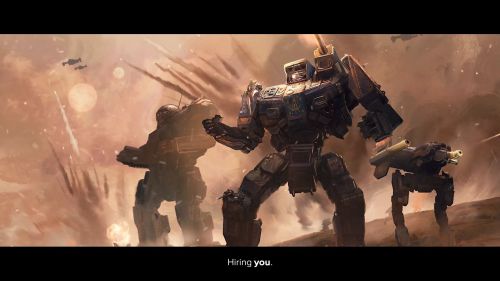
Wow spoilers much.
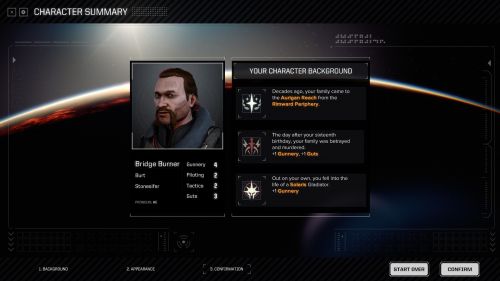
Aside from a (weirdly intentional) omission of blonds, the character creation is pretty encompassing.
Mechs & Potatoes
The core of BATTLETECH are the battles and the tech. Go figure.
[Disclaimer: I’m not familiar with the source material here so I can only judge BATTLETECH the PC game by what it is – though I will state that the misgivings of some of its more ardent players makes it seem as though the tabletop and digital experience are fairly different.]
BATTLEBECH’s battles are split between “freelance” randomized missions and story-missions. It’s similar to Emperor: Battle for Dune in its staccato timing but lacks usage of ‘controlling the strategic layer’ of games like Dawn of War: Dark Crusade. Despite that, both story and random missions are pinned to the larger star map and must be traveled to. Although it’s littered with places to go, the lack of player influence on the map does make it feel a bit barren. And you will make use of its plentiful space as each story-mission is often gated behind a bit of a time limit. During this downtime – or anytime, really – the player can manage a side hustle of pretending to be a mercenary.
On the mercenary missions the players discuss contracts with factions and decide whether to take more cash or a better haul of scrap. You can also give up on either to improve relations with the faction offering the job. I did not once give a damn about faction relations. You get awashed in cash real fast and there is no real fear of being a wanted criminal in a faction’s territories as the gameplay firmly sequesters itself in the mech battles. The lack of care for the factions further sapped the star map of any life (which is mostly unfortunate because it seems absolutely ripe with potential).
Each mission starts with a setup stage where you prep four mechs (a Lance) to take the field. This is the core of where you can alter your BATTLEMECH experience. For example, you can go all medium/heavy/assault mechs and just can-opener your way into the enemy lines, though you risk bearing the full brunt of their attacks hitting your fat, juicy ass. Or you can take a light mech or two with you to dive into enemy ranks, drawing fire which your dwarven machines duck with ease.
Mechs are piloted by mechwarriors, each one specialized into one of four ‘experience trees’, a variation of gunmanship, tanking, scouting, etc. If you take a Light mech, you want them piloted by your skilled runner who picks up dodge for moving, just for example. A leveled mechwarrior will have a selection of two tier-1 skills and a single tier-2 skill that better entrench their roles. The link between pilots and mechs isn’t especially complex, but it does the job. My only qualm with the pilot system is that doesn’t seem to decide if it wants an X-Com or XCOM approach to attrition. In X-Com it was common to lose soldiers, but in XCOM you had your A-team which you took everywhere. In BATTLERECH, you can expand your barracks to hire more pilots, which seems to indicate an expectation of casualties, but I never really got the feeling that the battles mirrored the implied injury/death rate. More interaction with the roster would be great as well. As of now, the only real interaction with them is a passive XP bonus you can acquire by building a training facility and the occasional morale alteration via text events.
Aside from the pilots, weapon-loadouts matter quite a bit. Weapons fall into four categories: missiles, ballistics, lasers, and short-range weaponry (flamers, machine-guns, small-lasers). Every weapon archetype has variations of its own. For example, missiles can be Long-Range power punchers that knock enemies off their feet, or you can go the shotgun route and spray Short-Range missiles into mechs at close range; Laser weaponry variates itself into categories that exchange firepower for better heat management; Auto Cannons like the AC20+ are the 88mm’s of the battlefield, but they’re so heavy they’ll eat up most of the usable weight for the mech. Lighter mechs can use machine-guns to pepper cockpits, not doing the most damage to the machine, but occasionally slipping a bullet into the man within.

A wide-diversity of weaponry gives you room for party experimentation.
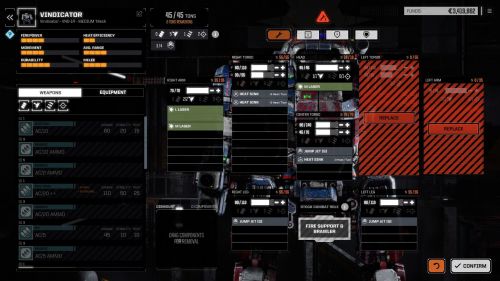
Your mechs are often in a constant state of change, whether by choice or need.
Tinkering with the mechs is the best part of the game right now. You are always balancing armor, weaponry, heat-management, and mobility, scrounging together an adhoc armament made of found and purchased weaponry. And sometimes you can make some hilarious designs. For example, I had a mech that had shoulder braced weaponry. With no immediate use for its gunhands, I stripped the armor down to fit more weaponry. In turn, the mech ran around the battlefield with its arms hanging by what I can only presume was woven pinestraw. It’d take but a stiff breeze for the limbs to go flying off like the pompoms of cheerleader hit by a train. What was left was a glorified fencepost leaning its shoulder lasers into enemies like a giant Men in Black neuralyzer. And it worked quite well in its own way.
Taking weapons on and off is so clearly a powerful utility that you even have to pay for it in-game: each time you swap gear around, the game’s mechanic gets to work and you’ll burn a few days doing the re-ups. Acquiring said weaponry is done through two routes: one is via the shops you stumble into at each node. I’m assuming these are those nice stores where the bell tinkles above you and a nice sci-fi Wilfred Brimley asks you to browse the flamethrowers under the glass counter. I know those places. The other, if not primary way, to get weapons is via battlefield leftovers.
Scrap is an important part of the game in regards to the mech management, though it remains a bit undercooked. After a battle, you’re free to take intact equipment off the battlefield. It’s kinda cool in theory: if you spot an enemy utilizing a badass weapon, you can be mindful to not blow it up so it’ll be around to pick up after the fight. It also provides a nice in-battle balance, because there was a couple of times when I had to decide between blowing that AC20 off the enemy before it punched a hole in my mech, or sparing the weapon so I could take it for myself. I’ve never tried so hard to land me some sloppy seconds.
But scrap is also relevant to how one gets a hold of new mechs. And it is the scraps of mechs in particular that end up turning the game’s mech management into a bit of whack-a-mole when it comes to actually acquiring those new machines. It feels strangely reductive to have a “collect 3, make mech” design, similar to something you’d find in a derivative mobile game. But mostly the problem is that there are so many mech types that you might be having scraps of them forever, and no doubt will send completionists on snipe hunts looking for that final piece. I’m sure it’s not in with the lore, but given the importance of mechs as battlefield dragons, I was hoping for some Frankenmechs like seen in Metal Fatigue years ago. Jerry rigging mechs out of a variety of makes/models would make ‘rebel’ forces look more rebellious and could serve as a visual measurement of the players own advancement from ad hoc mercenary to the spearpoint of a royal’s return.
Want some coke? Have some weed.
Alright. The Mech-universe is dumb. Despite man’s rapid expansion into the galaxy, and all the space-tech that entails, virtually every combat scenario is rusticated to a postage stamp of planet countryside. But I get it. I can suspend my disbelief to pretend these are essentially sci-fi medieval champions jousting on the backyard trampoline while dad’s inside doing a number on mom. It’s even – gasp – pretty cool. But what I have difficulty with is discarding what could be so many damn gameplay elements that would surely be entwined with mechs fighting one another.
For example, there’s little usage of interference between you and the enemy. There are no gradations in hit potentials. If an enemy can target your head, it can target everything. The concept of ‘hull down’ is absent, as are tactics like shooting off some smoke grenades to cover one’s advance. One concept rides the line of what I’m talking about: if you run really far you can accrue dodge pips that translate into you being harder to hit. But then on the flip side it’s just a hard percentage – if you get hit, you get hit. Glancing blows do not exist. Pretty sure my vacuum has more sloped armor than these mechs.
There’s also a strange appearance of melee in BATTLEMECH. Strange, because it’s there in multiple forms but there’s no actual melee weaponry being used. You can walk up to enemy mechs and bonk them with your cannon like you just walked Joe Pesci into a cornfield. Considering munitions will explode if struck by enemy fire, it’s an amusing sight to see mechs throw their actual weapons into strikes with reckless abandon. You can also stomp on downed mechs which, given said munition stores, would almost assuredly be like stepping on a giant mine. Though I will say it’s hilarious to watch American History Mechs as your pilots surround an enemy and take turns stomping it.
Then there is the option of flying into the air and slamming down on an enemy, one of the most devastating and awesome moves in the game. So devastating that there is an actual cost in that you seriously fuck up your mech’s legs in doing it. You also tend to lose any notion of (physical and no doubt mental) stability, often causing your mech to fall over. I should point out, though, that the cost is not too much when the end result is watching a giant mech do a toes-flat cliff dive on a foe’s face. (Side note: I began to wonder why nobody had developed a giant pogo-mech to terrorize the field. Seems so obvious, like how obviously overpowered those spinning bots are in Battle Bots.)
One glaring omission from this world lies outside the mechs themselves. Namely something one might call,fisting two holes at the same time combined arms. Military strategists realized the OP nature of air superiority back when that consisted of two kites stitched together and a pilot with a good throwing arm. One can only imagine the devastating nature of controlling the Z-axis when you elevate it into fucking space. I think it’s already kinda lousy how BATTLEMECH handles this enormous elephant in the room, but it got me to thinking if perhaps it could have been utilized without dampening the core of the game. Maybe put some hangars on the mothership to state that it has fighters on hand to defend it as it travels to and fro? And in-battle ‘air support’ would simply be a limited supply of strikes you could bring down, while the rest are implied to be warring for superiority as ground forces do the dirty work? That or just fly Oscar the Grouch’s mansion around a hostile galaxy where, apparently, no spies exist anywhere and you can spend days sitting on jump-ships waiting to take off like Donald Trump casually standing in line for a Cinnabon at the Mexico City International Airport. But I digress.
So why not some ground troops? Technically, there are a few in the form of tanks. And they’re hilariously powerful little buggers when you consider the cost-benefit ratio. It’s one of the few times the universe lets slip how silly it all is. Let’s analyze for a moment. A tiny tank can get jacked up on PCP lasers, giant cannons, or so many goddam missiles the animation of them smashing your mech lasts so long all it’s missing is a microwave’s timer going off at the end. They’re incredibly threatening – and also incredibly sparse. Presumably because they get close to threatening the mech’s limelight. Fine. Fair enough. Whatever. But boy… when I look at those curvaceous BATTLEMECH maps freckled with innocent rural pastorals, the first thing I imagine is having a host of combined arms thrashing it to bits with mechs striding gloriously through that which has been ravaged.
But it does isolate an issue with BATTLETECH’s entirety: the player’s ability to only take four mechs into combat forever traps the game design into a phonebooth only big enough to challenge that starting point. I still feel like the difference between X-Com and XCOM (1994, 2012) is a perfect example of the issue. In X-Com, you have numbers on hand which not only makes your decisions on map very flexible, it also means your enemies have a lot of flexibility as the game has to contend with the players deep well of resources. In XCOM, you usually roll a squad four-deep. Your gameplay options were so piled into those squaddies that losing even one meant a giant stepback in firepower and force projection (and losing a whole squad often meant game over). Enemies are not foes frantically looking to squash you so much as they are taking directorial cues on how to behave. In turn, the maps became static ‘Overwatch creep’ affairs where players tilted toward the strategically conservative choices. It took a sequel and its expansions to get anywhere close to fixing this. BATTLETECH suffers from a similar fate in its first steps.
That’s the primary reason I harp on this lack of, admittedly ancillary, tools. Because a game can only challenge a limited toolkit so much. If it throws too much at you, then you’ll end up having to lean on luck instead of tactical options at which point it feels more unfair than challenging. The corollary is that if the game throws too little, like many of the randomized mercenary missions, it leans into simply being boring. This is partly why the game’s best missions are those designed to stretch your resources horizontally, forcing you to spread out and cover geographical ground while also choosing between killing targets and protecting points. Rewarding players for eagerness is a design resource you can tap repeatedly and when BATTLETECH does this it does it well. But the core of XCOM laid itself bare real quick and I think BATTLETECH does as well. I imagine HBS will borrow the cues from Firaxis in figuring out ways to variate the gameplay and wrench it free of its current confines. (My simple suggestion is that combined arms would be a great way to do this.)
I should add that all of these ‘combined arms’ elements are actually shown in the game’s introduction. Animations abound of fighter jets zipping around, of enormous armies going on the march, of ground troops giving parades, of resistance fighters resisting, of tanks scrambling the earth getting shots in where they can, and above all this chaos righteously stand the mechs. Defiant. Tenacious. Equal parts horrifying and inspiring. But wait – how would they look if you stripped away all that surrounding mess and just had them standing in a field by themselves? If you play a game of Chess with all queens, are they still queens? If you give them a powerful toolkit of customizability the answer is a soft yes.
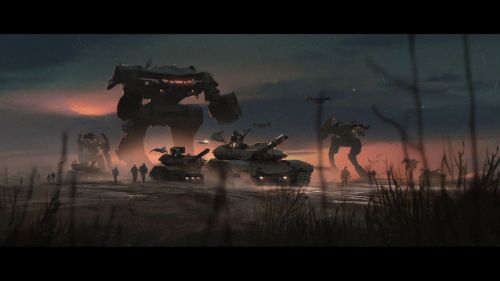
When nobody's looking, I tuck my junk, dress myself in this image, and dance in front of a Victorian mirror.
This is not at all an indictment of BATTLEKECH or HBS, but instead the fizzling patience I have for turn-based strategy games as a whole. I have something modern, yet I can point to numerous titles from yesteryear that supersede it in so many ways (including ones in this very universe). I should also mention the game does at times do a quick handwave of the glorious uber-battle happening offscreen. While you’re busy breaking a half-dozen eggs, the Princess will sometimes pipe in to relay that the super awesome battle she’s fighting is seriously hellacious and you need to hurry up or it’s going to get so dramatic that all might be lost. Sounds fun. I guess I’ll just act like I Auto Resolved it or something.
Battlefield Earth
At the start of each battle you’re dropped into a large 3D map. Maps are static with slight variations (e.g., by changing the player’s starting position or altering topographical details). Quite similar to Firaxis’s XCOM. The only issue is that the maps are just not especially exciting. Buildings might as well not be there – you walk through anything without an HP bar – and every map is a blob of putty colored white for snow, green for temperate, etc. The geography and urban elements rarely seem to have any influence in general.
For example, many maps have great swaths of forest. If a mech stands in a forest, can you still shoot the shit out of it with lasers and ballistics? The answer is yes. Trees serve zero impasse to weaponry, though they provide a slight abstracted defensive bonus. Given the enormity of firepower being slung around, I was hoping for some more destruction on the battlefield. If I shoot a PPC, a powerful energy spear with a Hadouken for a tip, I want that sucker burning a path through a forest. If the trees are on fire, why not have the smoke provide visual coverage? If we’re fighting in snowy mountains, is there not any threat of avalanches when I sling bombs into a couloir? What about slipping on anything?
Battles are usually far too short to make any use of the geography, especially the non-story missions, and this is highly reflective in the gameplay which quickly minimizes itself into mech vs. mech with very little interference. You get a huge map to look at, but very often fight close to the corner in which you started. It’s not unusual to go about one turn’s distance from your LZ and immediately start the battle – and not unusual to progress no further, distance-wise. What this really means is you’re not making much use of the terrain. Not that it matters too much anyway. There’s a hollow spatiality to mech combat that strips it of geographic considerations that make, say, tank combat a rigorous study.
Speaking of shooting exchanges, you do pretty much only hit the enemy. Scattering shots do not seem to exist nor does any form of fratricide despite the destructive breadth of weaponry being employed. For example, I sent a tiny Firestarter behind an Assault mech to flame it down. I then used my other mechs and shot at the Assault with a swarm of lasers and missiles. The Firestarter scratched his balls while all manner of apocalyptic hellfire zipped around him.
Story-missions are very hit or miss when it comes to utilizing the breadth of a map. For example, one had me tackling a host of turrets, then progressing to root some mechs out from behind a wall, then taking a position and holding it, then progressing to fight a boss. By the end of it a lot of my mechs were bruised and battered, their pilots injured, and a good deal of my munitions exhausted. Then I’d go on another mission and it’s like I’m fishing off the side of a dock, kicking my feet in the water as my mechs casually complete objectives. Speaking of objectives…
After a few missions, I became meta-aware of the design decisions. For example, some missions give you a time limit to handle something. It becomes obvious that completing the objective will only open up a second objective which is usually the more threatening of the two. So let’s say you’re tasked with destroying a building that is protected by a retinue of mechs. You could snipe it and seemingly bring the mission to a quick close. But that’s virtually never the solution. Because if you blow up the building it only sets off a trigger to the next mission event which is, invariably, pretty much always the arrival of reinforcements. So you get this strange disconnect between characters begging you to quickly take out an objective, and you being more measured because you know in the ethereal land of game design that something dreadful awaits beyond the completion of your objective.
Riddling the Middlemen
In a game that promotes absurd levels of min-maxing, BATTLETECH shockingly has no combat log to speak of. The ambiguities seem to fly against a setting of overwhelming technological exactness, but it also seems inappropriate in a turn-based tactics game predicated on getting the most out of a handful of units. This is especially apparent early on when you’re picking up the game. My experience was basically this: “Well, I’ll fire all these weapons and see what happens.” / Every weapon lands. / Enemy mech staggers for a second in animation, then the armor-pips suddenly disappear and the mech explodes. / “Interesting. What did we learn, Palmer?”
The game’s interface does a reasonable job given the task at hand. The turn sequencing is displayed at the top and movement is communicated well via a sort of ‘peg’ system. 3D “aiming” is handled via cones of fire and it’s explicitly detailed what you can shoot where you’re standing as well as what you can shoot at your new location before you actually move there. I will say that there are times when LOS goes right through places where it shouldn't, most noticeably with many buildings. Weapon systems are super simple: just a few buttons on the side, each clearly demonstrating how much heat they’ll produce and ammo they’ll use. Hit percentages can be analyzed by hovering over each individual weapon type, though I often found myself scratching my head. For example, go to one spot and a shot will be 85%, but take one step back and it drops to something like 45%. I can only assume this is an issue with the core rules being adapted. I do wish the interface was more explicitly clear at times. Force multipliers and circumstantial affects are tailored to poorly colored nodes. The interface in general feels somewhat crammed despite a lot of room left around for it to use, but I can see the difficulty of making it work at all to begin with so I think HBS did a very reasonable job of it.
Also on the interface is the game’s mana bar. They call it a “Morale” system but it is clearly mana. Hell, it’s even blue. Mana lets you either take an aimed shot or effectively button up. I’m not sure where in my LARPing this morale system fits. Anyone can use it, and anyone’s use drains it from the collective. Your pilots are either a collective hivemind or are reading each other's eyes like a team of Harlem Globetrotters. In summary, I think it’s a pretty dumb system at face value, but I also think its presence comes at the cost of greater complexity. A whole lot of tactical variance has been melted down into this system and it bugs the hell out of me.
At the Dark End of the Street
BATTLETECH’s music is great. I won’t pretend to know how to describe it, so I’ll put it like this: I still have the original CD to Homeworld’s soundtrack in my car. BATTLETECH doesn’t quite enter Homeworld’s strata, but I think it gets close. My only qualm is that the game rarely lets its music breathe like Homeworld did. Admittedly, Homeworld utilized an emotional cheat code in Adagio for Strings, but its overall use of music from mission-to-mission consistently captured the right feelings of desperation, wonderment, terror, etc. BATTLETECH’s music often gets washed out in other things happening on screen even during ‘dramatic’ moments (that or it's my speakers). Strangely enough, one of my favorite tracks is a simplistic tune of clanking metal that plays while you gear up the mechs. The main title song is definitely the strongest as far as I'm concerned, but the whole soundtrack is worth a listen on its own.
Sound effects are great. Mechs are heavy machines and BATTLETECH does a hell of a job giving weight to their movements. Through sound alone you get the notion that these things could run roughshod over damn near anything. Jump jets ignite with ferocious energy and when the mech sticks its vault there’s a sharp clatter of all its mechanisms compensating a ridiculous distribution of energy.
Every weapon feels right. Lasers, the biggest honeytraps of sound design in existence, pop and burst without sounding the least bit cartoonish, cannons fire with chunky blasts to really give them weight, missiles sound like missiles. Sounds of damage are wicked. Pieces explode with suitable fury, leaving mechs wobbling on strained metals as their detached limbs corkscrew away. When a mech is knocked down, you can hear its engine fighting to stay upright before succumbing to gravity with a series of unsettling clangs as parts not meant to be heard get shifted around.
The graphics of the game are a mix. On one hand, BATTLETECH’s artwork is stupendous. The cinematics are done with beautiful 2D images that are animated just barely enough to give them life without making them look comical. The art on the mechs is great. They look like giant killing machines with technological menace built into their broad-shouldered designs. Furthermore, you can actually see their armaments. I’m sure long-time players of the series could probably even identify the weapons through silhouette alone. It’s a great job. The art on the mechs themselves carry subtleties, like the way slag drips when a laser cuts the steel, or the way the gears pump steam as they gradually become overheated. The wear-and-tear of damage is evident as well, culminating in the total destruction of limbs, leaving behind twisted wires and naked gears for stumps.
On the other hand, the 3D side of things gets a little rough. As mentioned, the maps look like putty. I think the biggest problem is that things just feeeeel empty. Water doesn’t run, buildings stand empty, forests behave like tall grass. Now, I’m not asking for people to come tumbling out of shattered buildings like it’s Rampage, but I swear whenever I crash through a structure it looks like toy blocks getting kicked over. Forests are even more anemic. You’d think an enormous 100T machine would break a branch or two, but the trees just sorta wave around. Am I giant machine of death, or a tiny cricket getting ready to chirp at two in the morning? All of these can be improved, of course.
What seemingly can’t be improved is this little piece of shit called Unity.
Unity has so thoroughly pissed me off over the years that when its logo flashed I let slip an exasperated “goddammit” so real and authentic it would have won Jeff Bridges that Oscar. This real crackerjack of an engine boasts a unique combo of crap looking graphics and even worse performance. I’m convinced that it is for techno fetishists, something Cenobites would rub against a gamer’s PC. BATTLETECH has the overall appearance of a deflating dinghy and runs like Freddie Flintstone wearing busted Crocs. Most players seemed to complain about the heat it caused for their systems and mine was no different. At one point my game splintered into artifacts. (I can’t help but point out that complaining about heat generated from a video game while my great ancestors struggled for hours to create fire is immensely hilarious to me.) BATTLETECH crashed twice, neither of which was severe beyond the game closing so no big there. Graphics settings with BATTLEMECH are pretty reflective of all Unity games. Fidelity goes from fairly sharp to something postmodern.
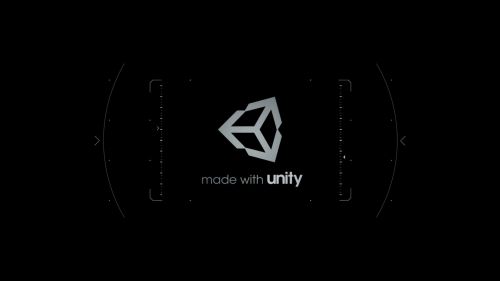
I've heard that if you say Unity three times into a mirror an amalgamation of melted graphics cards will appear.
Bugs plagued a lot of my time with BATTLETECH, often in bizarre ways. One strange occurrence is that going to the main menu in the middle of a mission does not actually stop the action. For example, if you go to save it on the enemy turn, the enemy’s turn will still progress in the background. The already beleaguered performance does not handle this interaction very well.
A few bugs mess with the gameplay. I had one mission where I was tasked with destroying a lance of mechs before their reinforcements arrived. Well, on Turn 1 the reinforcements “arrived”, the same way the cavalry “arrives” when I walk into a fucking stable. Humorously, mission control will warn about incoming reinforcements well after they’re attacking (or even after they’re dead). Another mission started me on the edge of a cliff with the enemy in the pit of a caldera. But the only way down the side of the cliff was by jumping – and one of my mechs did not have jump jets and the pilot refused to gently slide down like a puppy descending a flight of stairs. With no options available my mech was stranded and unusable for the mission.
There’s another irritating aspect to BATTLETECH that I can’t figure out if it’s a technical issue or something sincerely diabolical. After any chosen action, the game will stagger the action with pauses. I think it has to do with audio files waiting to spit out barks, but I’m not sure. Either way, this is the sequence: you tell a mech to attack. The game slow-zooms toward the action like it’s opening shots of The Shining. The mech turns and fires. The enemy mech is hit. It… it… it reacts. The armor pips don’t move, then suddenly fall off as though catching up with the events. And then… uh, nothing. The game just sits there for a few seconds. “Got him!” someone might say, and then the action goes back out. If you destroy the enemy it will sit there for a second and then promptly explode after a staggered animation. A hungover Vanna White has faster reveals than this nonsense.
It’s a remarkable lack of respect for the player’s time. I’m left wondering how many actual hours I spent waiting through these awkward delays. When you throw in bugs, crashes, and poor performance, this sort of thing is only a force multiplier for irking the player. It’s also curious from a genre perspective. A big part of real-time usurping turn-based games in the first place was the immediacy and fluidity of the former’s gameplay. I still remember when damn FMVs started seeping into some turn-based games just to compete at a marketing level (I forgive you, Civil War Generals). And they still do that – it’s just “live action” now. But any turn-based game should have the ability to quick-end any action, whether it’s moving or attacking. It’d be like leaving a sensitivity control out of an FPS game.
A Profound Pronoun (“Yeah, I’m going to get into this.” “Probably shouldn’t, though.” “Yeah actually on second thought oh whoops –)
BATTLETECH released with some “politics in gaming” controversy, that ever lovely topic. It only makes sense that as gamers get older we get our own soap operas. In this case, most of the controversy erupted over a word:
THEY.
Of course, pinpointing the controversy on a single word is an obvious simplification. While there’s no doubt a steady population of people who care way too much about what other people do in their personal lives, the core of these controversies inexplicably involves people who probably don’t even disagree, yet their getting tangled up anyway rarely analyzes the circumstances that made it happen. The way folks mistaken disagreement of opinion with total vilification of personhood has soured any notion of nuanced dialogue. I believe the controversy arose because ‘They’ hints at yet another exhausting assault of social peacocking. Said modern peacocking is basically like watching that strange dance sequence in Metropolis and if you say "man this is kinda weird" someone shoots you in the face with a shotgun.
Too many “Hey, what’s up, by the way I’m [irregular social archetype]” characters in a row will have that effect. If a writer reacts to criticism of a trans character as an assault on transsexuality in general, it’s because that writer reduced said character to that single characteristic. Because they utilized a hot-button issue for a character, they then garner the support of people whose real-life experiences might be dour, which in turn no doubt attracts the trolls who created those dour experiences, and so within an instant a simple critique about a boring character turns into social commentary and there’s enough flak on the periphery to make everyone assume the worst of each other. Well I’m only interested in strong characters. Atlas Shrugged is boring drivel with cardboard cutouts who behave about as human as a Wikipedia article. Replacing Ayn Rand with the authorship of Twitter or Tumblr does not an improvement make.
Due to personal reasons, I’m actually more ‘studied’ on the topic than I was a few years ago. I’ll say this, ‘They’ is as big of an introduction to transsexuality as a yo-yo is to the Hadron Collider. Compared to Twitter, ‘They’ is you starting a mountain climb by sitting cross-legged outside a café, lowering the daily news, and thinking, “I should travel.” Compared to Tumblr, ‘They’ is that point of the Big Bang where everything just went completely wrong. You know, the part where God went, “Fffffffff.”
They’s inclusion in BATTLETECH comes at the character creation screen. And that’s about it. I’m not even sure what point is made, but it’s there and it doesn’t do anything really. Maybe that is the point. Maybe nuance and subtlety have returned (lololol). I will say this about the ‘culture’ war which is infected with the opportunists and charlatans on all sides, I don’t think BATTLETECH has any sort of ill-intent with this one-word device. And it does not make the error of other games which shoehorn this topic in. You know, the obvious claptrap that breaks the fourth wall and completely murders immersion so the brave writer can pat themselves on the back. In BATTLETECH, ‘They’ is basically a bumper sticker. You can barely read it to begin with and it’s not going to change your mind when you do. Like any bumper sticker, it’s clearly for the driver and there’s nothing wrong with that.
Except one cynical possibility remains, which is that They provides a red herring to a more glaring issue concerning the overall quality of BATTLETECH’s writing. Although I am at times genuinely impressed with the medium, like the recent LISA or West of Loathing, game writing is almost inherently messy. It comes with the territory because there are simply so many moving parts, most notably the way it is consumed. Imagine if chefs had to contend with Yelp reviews when they didn’t even know which orifice the customer put the food into. Shit (literally) would be bananas.

The game's story begins with murderous usurpers doing you a solid, as the villain helpfully explains here. And then a massive airstrike (that's the thing I was talking about!) levels that entire city center killing just about everyone except a main character of course. The villains then remember the point of usurping thrones and decide they should kill the Princess again, but you and another dude fight off mechs in a final stand and you should both be dead but survive of course, and the Princess escapes on a dropship which is promptly blown out of the sky which I thought was just absolutely rich. Oh and obviously she survives as well. Awesome.

Glad my single display of tactical prowess wiped away any personality concerns that I'd sell you out in a heartbeat.
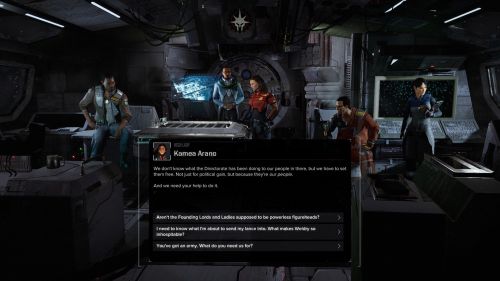
Utilizing inspirational prison breaks to bolster your ranks is exactly what ISIS did. Really activates those almonds.
BATTLETECH’s writing quality is all over the place. First off, the events. Events are little flavor texts that appear randomly as you jet about the galaxy. You’ll have events tied to where you are, who you are, and what you’ve done. They’re technically well written, each being fairly terse (unlike Battle Brothers) without sacrificing too much in the way of actual prose. My only real qualm with the events is that they rarely require much player input. You don’t have to “read” too much into the options on hand as the most beneficial one is almost always obvious. For example, if you have people being unruly, the “how about you act like I’m fucking paying you to do a job” option only lowers morale – there’s no reward to it despite some folks being receptive to unerring rule. The “con/pro” aspect is too frequently employed in this way. This isn’t really BATTLETECH issue, it just comes with the territory of event writing. I first and foremost consume events as purely flavor text and from that angle they’re great.
The other aspect of BATTLETECH’s handled well is the way in which it provides background information. I abhor lore dumps. Thankfully, BATTLETECH gates its surprisingly deep lore behind distinctly highlighted lore phrases. If a character says they’re from some area, you can hover over the word itself and it’ll tell you the backstory. It’s a good way to keep the flow going instead of the characters awkwardly talking about shit that, story-wise, they should already know and not need to expound upon.
Where BATTLETECH noticeably falters is in the plot and characters. There is also a strange stylistic change between non-event writing and event writing. While events are written fairly straight, the main game’s writing has a lot of characters talking like this:
“I told you – A THOUSAND TIMES – to not… sigh… microwave the burrito with the foil on.”
The stilted orthography is a sort of sci-fi mirror to the campestral style of a ten-cent Western. Fair enough, but every character talks like this. If you pulled dialogue from the game and hid its speaker, you wouldn’t even know who the hell was talking. A lack of distinction and differentiation between characters is somewhat ironic since, like most sci-fi settings, the cast is a Captain Planet’s catalogue of diversity. One big red flag for this unexotic “dialogue” is that every single character is a certified ass kisser. There is only passing resistance to any of the Princess’s goals or ideas. With a large cast of characters, the matter of getting from point A to point B has about as much conflict as going from 1-1 to 1-2 in Super Mario. The unending rimjobbing she gets also stands in stark contrast to the actual plot's conceit.
And a quick recap of said plot: you are a financially insolvent killer for hire and there is a deposed princess who wants to take back the throne. This is a great premise. Story-wise, it is intriguing. The mercenary has debts to pay and the princess needs to recapture her throne. I immediately jumped to the obvious question. Why doesn’t the mercenary just fork over the princess to those who own the throne? What could the princess possibly reward him for years of struggle and uncertainty that would be better than a simple phonecall to the current royals? Not only is this a fun narrative, it could feed directly into gameplay with difficult decisions to make.
Except at no point whatsoever is there any tension between a person who murders for cash and a person who is essentially a Disney Princess. The toothless premise most noticeably sends a wrench into the issue of cashflow. In-game, the Princess is bankrolled by an outside power yet you can ostensibly still run out of treasury. It seems to me that the better concept would be for the player to play as the Princess who must hire the mercenary, and if you run out of treasury then the mercenary turns on you. Meanwhile, the mercenary smells blood in the water and keeps making bigger and bigger demands. I don’t know, just thinking out loud here. It’d be cool if the player’s story was front and center instead of every accomplishment’s limelight being afforded to a Mary Sue with a scar, but I digress. What's clear is that you are not a mercenary at all, which is kind of awkward considering the non-story contracts you undertake. Instead you fall into one of those awkward gaming tropes; that one where the shopkeeper wants you to save the world, but he still finds the time to demand you pay a couple quid for the very tool you need despite the implication that any failure on your part would also be his doom.
The debris of this blown idea peppers the rest of the game’s writing: the plot never really deviates from good vs. evil, and it’s almost patronizing how thoroughly it makes sure you know who has the halo who the horns. At one point it even lampshades itself when a villain talks like a toddler about their evil plans, but the device felt out of place in the setting and served to only further highlight how doldrum the whole thing was. Not to mention said evilness coming to fruition pretty much gets hand waved away which was about the point I gave up on expecting more.
I’ve never played a game that so badly wanted me to dislike its protagonists like BATTLETECH does, but the worst bootlicker of them all is the player. So divested is the player from the mercenary concept, you bend over backwards for the Princess at every opportunity. Dialogue options range from “Yes ma’am” to “Sure I’ll do it.” Again, just to reiterate, you struggled for years to survive after the opening act. You literally killed people to put food on the table. Yet after meeting a royal princess who got beaten by the bigger animal in a Hobbesian setting you simply can’t salute her fast enough. Just have everyone scissoring each other in mission control and call it a day why don’t you.

Either somebody is stirring a lot of macaroni or there is some serious action going down on that ship.
In Summary
BATTLETECH is an alright game and I look forward to seeing if the expansions reach its enormous potential/10.
Disclaimer: I received a copy for the expressed purpose of reviewing the game.
When news came of XCOM getting a proper “AAA” treatment a few years ago, I was ecstatic. When I learned that it was to be an FPS based in the 1950s with oil slicks for monsters, I got so angry I could have rioted – which is saying a lot coming from a man who has unironically worn a turtleneck. The turn-based genre had not only been treading water for years, it was occasionally opening its mouth to suck in some public pool tang just to stay hydrated. It is a genre that’s never been truly perfected. It’s the ultimate Sisyphean design nightmare, for if you give the player infinite time (pauses) to choose actions, then the given levels of abstraction are almost limitless. And the more you abstract, the more you simulate, the more aware you become of that which is not simulated.
BATTLETECH is another iteration of the turn-based genre from Harebrained Schemes. It is a mash of battlemap turn-based combat and overworld-traveling mercenary management. The game is advertised as the “next generation of turn-based tactical ‘Mech combat.”
If that’s the truth, please turn back the clocks.
Selling bottled water in a desert.
BATTLETECH is introduced with an amazing cinematic and I mean that very sincerely. It is a visual masterpiece, succinctly bringing the player up to speed without using a single line of dialogue. The most “said” is that by a young nobleman whose wile smile belies the carnage his naivety is about to wreak. The rest is told through a mesh of beautiful music and artwork, spliced together so cleanly that the viewer can fill in the details themselves. Cutscenes and introductions are a dime a dozen these days and even the good ones seem a little rote with the way Tripe-A studios will slam around multi-million dollar budgets so much you can almost see the accountants laundering money in the overused CGI. BATTLETECH’s hands-off intro stands out by comparison.
You start the game itself by creating a character. This includes background storylines and combat attributes as your character will be partaking in dialogue and action alike. After this, you’re immediately treated to what I think is BATTLETECH’s first misstep, which is the cinematic that opens the game itself. It establishes the story as a done deal, the Princess won with you at her side. The “this happened, but how it happened is up to you” trope seems a little ill-suited here and at no point were its contours flexed. After that narrative device is played, you’re more or less thrown into the moment of chaos: a kingdom’s ruler has passed and neo-medieval underlings start going after each other’s throats. The player escapes and their fairmaiden princess allegedly explodes on her escape route (should’ve, IMO). Except you know she doesn’t because, well, she was in the intro telling you she was the game’s winner.
The game picks up three years later with the player having since come to run a mercenary company. The lady who died but you know is not dead shows up as not dead. Your primary motivation going forward is to help her because, uh, reasons I guess. With that settled, you get into the meat of the game: managing mechs, their mechwarriors (pilots), keeping a scrappy ship in shape, and eventually fighting on smaller battle maps.

Wow spoilers much.

Aside from a (weirdly intentional) omission of blonds, the character creation is pretty encompassing.
Mechs & Potatoes
The core of BATTLETECH are the battles and the tech. Go figure.
[Disclaimer: I’m not familiar with the source material here so I can only judge BATTLETECH the PC game by what it is – though I will state that the misgivings of some of its more ardent players makes it seem as though the tabletop and digital experience are fairly different.]
BATTLEBECH’s battles are split between “freelance” randomized missions and story-missions. It’s similar to Emperor: Battle for Dune in its staccato timing but lacks usage of ‘controlling the strategic layer’ of games like Dawn of War: Dark Crusade. Despite that, both story and random missions are pinned to the larger star map and must be traveled to. Although it’s littered with places to go, the lack of player influence on the map does make it feel a bit barren. And you will make use of its plentiful space as each story-mission is often gated behind a bit of a time limit. During this downtime – or anytime, really – the player can manage a side hustle of pretending to be a mercenary.
On the mercenary missions the players discuss contracts with factions and decide whether to take more cash or a better haul of scrap. You can also give up on either to improve relations with the faction offering the job. I did not once give a damn about faction relations. You get awashed in cash real fast and there is no real fear of being a wanted criminal in a faction’s territories as the gameplay firmly sequesters itself in the mech battles. The lack of care for the factions further sapped the star map of any life (which is mostly unfortunate because it seems absolutely ripe with potential).
Each mission starts with a setup stage where you prep four mechs (a Lance) to take the field. This is the core of where you can alter your BATTLEMECH experience. For example, you can go all medium/heavy/assault mechs and just can-opener your way into the enemy lines, though you risk bearing the full brunt of their attacks hitting your fat, juicy ass. Or you can take a light mech or two with you to dive into enemy ranks, drawing fire which your dwarven machines duck with ease.
Mechs are piloted by mechwarriors, each one specialized into one of four ‘experience trees’, a variation of gunmanship, tanking, scouting, etc. If you take a Light mech, you want them piloted by your skilled runner who picks up dodge for moving, just for example. A leveled mechwarrior will have a selection of two tier-1 skills and a single tier-2 skill that better entrench their roles. The link between pilots and mechs isn’t especially complex, but it does the job. My only qualm with the pilot system is that doesn’t seem to decide if it wants an X-Com or XCOM approach to attrition. In X-Com it was common to lose soldiers, but in XCOM you had your A-team which you took everywhere. In BATTLERECH, you can expand your barracks to hire more pilots, which seems to indicate an expectation of casualties, but I never really got the feeling that the battles mirrored the implied injury/death rate. More interaction with the roster would be great as well. As of now, the only real interaction with them is a passive XP bonus you can acquire by building a training facility and the occasional morale alteration via text events.
Aside from the pilots, weapon-loadouts matter quite a bit. Weapons fall into four categories: missiles, ballistics, lasers, and short-range weaponry (flamers, machine-guns, small-lasers). Every weapon archetype has variations of its own. For example, missiles can be Long-Range power punchers that knock enemies off their feet, or you can go the shotgun route and spray Short-Range missiles into mechs at close range; Laser weaponry variates itself into categories that exchange firepower for better heat management; Auto Cannons like the AC20+ are the 88mm’s of the battlefield, but they’re so heavy they’ll eat up most of the usable weight for the mech. Lighter mechs can use machine-guns to pepper cockpits, not doing the most damage to the machine, but occasionally slipping a bullet into the man within.

A wide-diversity of weaponry gives you room for party experimentation.

Your mechs are often in a constant state of change, whether by choice or need.
Tinkering with the mechs is the best part of the game right now. You are always balancing armor, weaponry, heat-management, and mobility, scrounging together an adhoc armament made of found and purchased weaponry. And sometimes you can make some hilarious designs. For example, I had a mech that had shoulder braced weaponry. With no immediate use for its gunhands, I stripped the armor down to fit more weaponry. In turn, the mech ran around the battlefield with its arms hanging by what I can only presume was woven pinestraw. It’d take but a stiff breeze for the limbs to go flying off like the pompoms of cheerleader hit by a train. What was left was a glorified fencepost leaning its shoulder lasers into enemies like a giant Men in Black neuralyzer. And it worked quite well in its own way.
Taking weapons on and off is so clearly a powerful utility that you even have to pay for it in-game: each time you swap gear around, the game’s mechanic gets to work and you’ll burn a few days doing the re-ups. Acquiring said weaponry is done through two routes: one is via the shops you stumble into at each node. I’m assuming these are those nice stores where the bell tinkles above you and a nice sci-fi Wilfred Brimley asks you to browse the flamethrowers under the glass counter. I know those places. The other, if not primary way, to get weapons is via battlefield leftovers.
Scrap is an important part of the game in regards to the mech management, though it remains a bit undercooked. After a battle, you’re free to take intact equipment off the battlefield. It’s kinda cool in theory: if you spot an enemy utilizing a badass weapon, you can be mindful to not blow it up so it’ll be around to pick up after the fight. It also provides a nice in-battle balance, because there was a couple of times when I had to decide between blowing that AC20 off the enemy before it punched a hole in my mech, or sparing the weapon so I could take it for myself. I’ve never tried so hard to land me some sloppy seconds.
But scrap is also relevant to how one gets a hold of new mechs. And it is the scraps of mechs in particular that end up turning the game’s mech management into a bit of whack-a-mole when it comes to actually acquiring those new machines. It feels strangely reductive to have a “collect 3, make mech” design, similar to something you’d find in a derivative mobile game. But mostly the problem is that there are so many mech types that you might be having scraps of them forever, and no doubt will send completionists on snipe hunts looking for that final piece. I’m sure it’s not in with the lore, but given the importance of mechs as battlefield dragons, I was hoping for some Frankenmechs like seen in Metal Fatigue years ago. Jerry rigging mechs out of a variety of makes/models would make ‘rebel’ forces look more rebellious and could serve as a visual measurement of the players own advancement from ad hoc mercenary to the spearpoint of a royal’s return.
Want some coke? Have some weed.
Alright. The Mech-universe is dumb. Despite man’s rapid expansion into the galaxy, and all the space-tech that entails, virtually every combat scenario is rusticated to a postage stamp of planet countryside. But I get it. I can suspend my disbelief to pretend these are essentially sci-fi medieval champions jousting on the backyard trampoline while dad’s inside doing a number on mom. It’s even – gasp – pretty cool. But what I have difficulty with is discarding what could be so many damn gameplay elements that would surely be entwined with mechs fighting one another.
For example, there’s little usage of interference between you and the enemy. There are no gradations in hit potentials. If an enemy can target your head, it can target everything. The concept of ‘hull down’ is absent, as are tactics like shooting off some smoke grenades to cover one’s advance. One concept rides the line of what I’m talking about: if you run really far you can accrue dodge pips that translate into you being harder to hit. But then on the flip side it’s just a hard percentage – if you get hit, you get hit. Glancing blows do not exist. Pretty sure my vacuum has more sloped armor than these mechs.
There’s also a strange appearance of melee in BATTLEMECH. Strange, because it’s there in multiple forms but there’s no actual melee weaponry being used. You can walk up to enemy mechs and bonk them with your cannon like you just walked Joe Pesci into a cornfield. Considering munitions will explode if struck by enemy fire, it’s an amusing sight to see mechs throw their actual weapons into strikes with reckless abandon. You can also stomp on downed mechs which, given said munition stores, would almost assuredly be like stepping on a giant mine. Though I will say it’s hilarious to watch American History Mechs as your pilots surround an enemy and take turns stomping it.
Then there is the option of flying into the air and slamming down on an enemy, one of the most devastating and awesome moves in the game. So devastating that there is an actual cost in that you seriously fuck up your mech’s legs in doing it. You also tend to lose any notion of (physical and no doubt mental) stability, often causing your mech to fall over. I should point out, though, that the cost is not too much when the end result is watching a giant mech do a toes-flat cliff dive on a foe’s face. (Side note: I began to wonder why nobody had developed a giant pogo-mech to terrorize the field. Seems so obvious, like how obviously overpowered those spinning bots are in Battle Bots.)
One glaring omission from this world lies outside the mechs themselves. Namely something one might call,
So why not some ground troops? Technically, there are a few in the form of tanks. And they’re hilariously powerful little buggers when you consider the cost-benefit ratio. It’s one of the few times the universe lets slip how silly it all is. Let’s analyze for a moment. A tiny tank can get jacked up on PCP lasers, giant cannons, or so many goddam missiles the animation of them smashing your mech lasts so long all it’s missing is a microwave’s timer going off at the end. They’re incredibly threatening – and also incredibly sparse. Presumably because they get close to threatening the mech’s limelight. Fine. Fair enough. Whatever. But boy… when I look at those curvaceous BATTLEMECH maps freckled with innocent rural pastorals, the first thing I imagine is having a host of combined arms thrashing it to bits with mechs striding gloriously through that which has been ravaged.
But it does isolate an issue with BATTLETECH’s entirety: the player’s ability to only take four mechs into combat forever traps the game design into a phonebooth only big enough to challenge that starting point. I still feel like the difference between X-Com and XCOM (1994, 2012) is a perfect example of the issue. In X-Com, you have numbers on hand which not only makes your decisions on map very flexible, it also means your enemies have a lot of flexibility as the game has to contend with the players deep well of resources. In XCOM, you usually roll a squad four-deep. Your gameplay options were so piled into those squaddies that losing even one meant a giant stepback in firepower and force projection (and losing a whole squad often meant game over). Enemies are not foes frantically looking to squash you so much as they are taking directorial cues on how to behave. In turn, the maps became static ‘Overwatch creep’ affairs where players tilted toward the strategically conservative choices. It took a sequel and its expansions to get anywhere close to fixing this. BATTLETECH suffers from a similar fate in its first steps.
That’s the primary reason I harp on this lack of, admittedly ancillary, tools. Because a game can only challenge a limited toolkit so much. If it throws too much at you, then you’ll end up having to lean on luck instead of tactical options at which point it feels more unfair than challenging. The corollary is that if the game throws too little, like many of the randomized mercenary missions, it leans into simply being boring. This is partly why the game’s best missions are those designed to stretch your resources horizontally, forcing you to spread out and cover geographical ground while also choosing between killing targets and protecting points. Rewarding players for eagerness is a design resource you can tap repeatedly and when BATTLETECH does this it does it well. But the core of XCOM laid itself bare real quick and I think BATTLETECH does as well. I imagine HBS will borrow the cues from Firaxis in figuring out ways to variate the gameplay and wrench it free of its current confines. (My simple suggestion is that combined arms would be a great way to do this.)
I should add that all of these ‘combined arms’ elements are actually shown in the game’s introduction. Animations abound of fighter jets zipping around, of enormous armies going on the march, of ground troops giving parades, of resistance fighters resisting, of tanks scrambling the earth getting shots in where they can, and above all this chaos righteously stand the mechs. Defiant. Tenacious. Equal parts horrifying and inspiring. But wait – how would they look if you stripped away all that surrounding mess and just had them standing in a field by themselves? If you play a game of Chess with all queens, are they still queens? If you give them a powerful toolkit of customizability the answer is a soft yes.

When nobody's looking, I tuck my junk, dress myself in this image, and dance in front of a Victorian mirror.
This is not at all an indictment of BATTLEKECH or HBS, but instead the fizzling patience I have for turn-based strategy games as a whole. I have something modern, yet I can point to numerous titles from yesteryear that supersede it in so many ways (including ones in this very universe). I should also mention the game does at times do a quick handwave of the glorious uber-battle happening offscreen. While you’re busy breaking a half-dozen eggs, the Princess will sometimes pipe in to relay that the super awesome battle she’s fighting is seriously hellacious and you need to hurry up or it’s going to get so dramatic that all might be lost. Sounds fun. I guess I’ll just act like I Auto Resolved it or something.
Battlefield Earth
At the start of each battle you’re dropped into a large 3D map. Maps are static with slight variations (e.g., by changing the player’s starting position or altering topographical details). Quite similar to Firaxis’s XCOM. The only issue is that the maps are just not especially exciting. Buildings might as well not be there – you walk through anything without an HP bar – and every map is a blob of putty colored white for snow, green for temperate, etc. The geography and urban elements rarely seem to have any influence in general.
For example, many maps have great swaths of forest. If a mech stands in a forest, can you still shoot the shit out of it with lasers and ballistics? The answer is yes. Trees serve zero impasse to weaponry, though they provide a slight abstracted defensive bonus. Given the enormity of firepower being slung around, I was hoping for some more destruction on the battlefield. If I shoot a PPC, a powerful energy spear with a Hadouken for a tip, I want that sucker burning a path through a forest. If the trees are on fire, why not have the smoke provide visual coverage? If we’re fighting in snowy mountains, is there not any threat of avalanches when I sling bombs into a couloir? What about slipping on anything?
Battles are usually far too short to make any use of the geography, especially the non-story missions, and this is highly reflective in the gameplay which quickly minimizes itself into mech vs. mech with very little interference. You get a huge map to look at, but very often fight close to the corner in which you started. It’s not unusual to go about one turn’s distance from your LZ and immediately start the battle – and not unusual to progress no further, distance-wise. What this really means is you’re not making much use of the terrain. Not that it matters too much anyway. There’s a hollow spatiality to mech combat that strips it of geographic considerations that make, say, tank combat a rigorous study.
Speaking of shooting exchanges, you do pretty much only hit the enemy. Scattering shots do not seem to exist nor does any form of fratricide despite the destructive breadth of weaponry being employed. For example, I sent a tiny Firestarter behind an Assault mech to flame it down. I then used my other mechs and shot at the Assault with a swarm of lasers and missiles. The Firestarter scratched his balls while all manner of apocalyptic hellfire zipped around him.
Story-missions are very hit or miss when it comes to utilizing the breadth of a map. For example, one had me tackling a host of turrets, then progressing to root some mechs out from behind a wall, then taking a position and holding it, then progressing to fight a boss. By the end of it a lot of my mechs were bruised and battered, their pilots injured, and a good deal of my munitions exhausted. Then I’d go on another mission and it’s like I’m fishing off the side of a dock, kicking my feet in the water as my mechs casually complete objectives. Speaking of objectives…
After a few missions, I became meta-aware of the design decisions. For example, some missions give you a time limit to handle something. It becomes obvious that completing the objective will only open up a second objective which is usually the more threatening of the two. So let’s say you’re tasked with destroying a building that is protected by a retinue of mechs. You could snipe it and seemingly bring the mission to a quick close. But that’s virtually never the solution. Because if you blow up the building it only sets off a trigger to the next mission event which is, invariably, pretty much always the arrival of reinforcements. So you get this strange disconnect between characters begging you to quickly take out an objective, and you being more measured because you know in the ethereal land of game design that something dreadful awaits beyond the completion of your objective.
Riddling the Middlemen
In a game that promotes absurd levels of min-maxing, BATTLETECH shockingly has no combat log to speak of. The ambiguities seem to fly against a setting of overwhelming technological exactness, but it also seems inappropriate in a turn-based tactics game predicated on getting the most out of a handful of units. This is especially apparent early on when you’re picking up the game. My experience was basically this: “Well, I’ll fire all these weapons and see what happens.” / Every weapon lands. / Enemy mech staggers for a second in animation, then the armor-pips suddenly disappear and the mech explodes. / “Interesting. What did we learn, Palmer?”
The game’s interface does a reasonable job given the task at hand. The turn sequencing is displayed at the top and movement is communicated well via a sort of ‘peg’ system. 3D “aiming” is handled via cones of fire and it’s explicitly detailed what you can shoot where you’re standing as well as what you can shoot at your new location before you actually move there. I will say that there are times when LOS goes right through places where it shouldn't, most noticeably with many buildings. Weapon systems are super simple: just a few buttons on the side, each clearly demonstrating how much heat they’ll produce and ammo they’ll use. Hit percentages can be analyzed by hovering over each individual weapon type, though I often found myself scratching my head. For example, go to one spot and a shot will be 85%, but take one step back and it drops to something like 45%. I can only assume this is an issue with the core rules being adapted. I do wish the interface was more explicitly clear at times. Force multipliers and circumstantial affects are tailored to poorly colored nodes. The interface in general feels somewhat crammed despite a lot of room left around for it to use, but I can see the difficulty of making it work at all to begin with so I think HBS did a very reasonable job of it.
Also on the interface is the game’s mana bar. They call it a “Morale” system but it is clearly mana. Hell, it’s even blue. Mana lets you either take an aimed shot or effectively button up. I’m not sure where in my LARPing this morale system fits. Anyone can use it, and anyone’s use drains it from the collective. Your pilots are either a collective hivemind or are reading each other's eyes like a team of Harlem Globetrotters. In summary, I think it’s a pretty dumb system at face value, but I also think its presence comes at the cost of greater complexity. A whole lot of tactical variance has been melted down into this system and it bugs the hell out of me.
At the Dark End of the Street
BATTLETECH’s music is great. I won’t pretend to know how to describe it, so I’ll put it like this: I still have the original CD to Homeworld’s soundtrack in my car. BATTLETECH doesn’t quite enter Homeworld’s strata, but I think it gets close. My only qualm is that the game rarely lets its music breathe like Homeworld did. Admittedly, Homeworld utilized an emotional cheat code in Adagio for Strings, but its overall use of music from mission-to-mission consistently captured the right feelings of desperation, wonderment, terror, etc. BATTLETECH’s music often gets washed out in other things happening on screen even during ‘dramatic’ moments (that or it's my speakers). Strangely enough, one of my favorite tracks is a simplistic tune of clanking metal that plays while you gear up the mechs. The main title song is definitely the strongest as far as I'm concerned, but the whole soundtrack is worth a listen on its own.
Sound effects are great. Mechs are heavy machines and BATTLETECH does a hell of a job giving weight to their movements. Through sound alone you get the notion that these things could run roughshod over damn near anything. Jump jets ignite with ferocious energy and when the mech sticks its vault there’s a sharp clatter of all its mechanisms compensating a ridiculous distribution of energy.
Every weapon feels right. Lasers, the biggest honeytraps of sound design in existence, pop and burst without sounding the least bit cartoonish, cannons fire with chunky blasts to really give them weight, missiles sound like missiles. Sounds of damage are wicked. Pieces explode with suitable fury, leaving mechs wobbling on strained metals as their detached limbs corkscrew away. When a mech is knocked down, you can hear its engine fighting to stay upright before succumbing to gravity with a series of unsettling clangs as parts not meant to be heard get shifted around.
The graphics of the game are a mix. On one hand, BATTLETECH’s artwork is stupendous. The cinematics are done with beautiful 2D images that are animated just barely enough to give them life without making them look comical. The art on the mechs is great. They look like giant killing machines with technological menace built into their broad-shouldered designs. Furthermore, you can actually see their armaments. I’m sure long-time players of the series could probably even identify the weapons through silhouette alone. It’s a great job. The art on the mechs themselves carry subtleties, like the way slag drips when a laser cuts the steel, or the way the gears pump steam as they gradually become overheated. The wear-and-tear of damage is evident as well, culminating in the total destruction of limbs, leaving behind twisted wires and naked gears for stumps.
On the other hand, the 3D side of things gets a little rough. As mentioned, the maps look like putty. I think the biggest problem is that things just feeeeel empty. Water doesn’t run, buildings stand empty, forests behave like tall grass. Now, I’m not asking for people to come tumbling out of shattered buildings like it’s Rampage, but I swear whenever I crash through a structure it looks like toy blocks getting kicked over. Forests are even more anemic. You’d think an enormous 100T machine would break a branch or two, but the trees just sorta wave around. Am I giant machine of death, or a tiny cricket getting ready to chirp at two in the morning? All of these can be improved, of course.
What seemingly can’t be improved is this little piece of shit called Unity.
Unity has so thoroughly pissed me off over the years that when its logo flashed I let slip an exasperated “goddammit” so real and authentic it would have won Jeff Bridges that Oscar. This real crackerjack of an engine boasts a unique combo of crap looking graphics and even worse performance. I’m convinced that it is for techno fetishists, something Cenobites would rub against a gamer’s PC. BATTLETECH has the overall appearance of a deflating dinghy and runs like Freddie Flintstone wearing busted Crocs. Most players seemed to complain about the heat it caused for their systems and mine was no different. At one point my game splintered into artifacts. (I can’t help but point out that complaining about heat generated from a video game while my great ancestors struggled for hours to create fire is immensely hilarious to me.) BATTLETECH crashed twice, neither of which was severe beyond the game closing so no big there. Graphics settings with BATTLEMECH are pretty reflective of all Unity games. Fidelity goes from fairly sharp to something postmodern.

I've heard that if you say Unity three times into a mirror an amalgamation of melted graphics cards will appear.
Bugs plagued a lot of my time with BATTLETECH, often in bizarre ways. One strange occurrence is that going to the main menu in the middle of a mission does not actually stop the action. For example, if you go to save it on the enemy turn, the enemy’s turn will still progress in the background. The already beleaguered performance does not handle this interaction very well.
A few bugs mess with the gameplay. I had one mission where I was tasked with destroying a lance of mechs before their reinforcements arrived. Well, on Turn 1 the reinforcements “arrived”, the same way the cavalry “arrives” when I walk into a fucking stable. Humorously, mission control will warn about incoming reinforcements well after they’re attacking (or even after they’re dead). Another mission started me on the edge of a cliff with the enemy in the pit of a caldera. But the only way down the side of the cliff was by jumping – and one of my mechs did not have jump jets and the pilot refused to gently slide down like a puppy descending a flight of stairs. With no options available my mech was stranded and unusable for the mission.
There’s another irritating aspect to BATTLETECH that I can’t figure out if it’s a technical issue or something sincerely diabolical. After any chosen action, the game will stagger the action with pauses. I think it has to do with audio files waiting to spit out barks, but I’m not sure. Either way, this is the sequence: you tell a mech to attack. The game slow-zooms toward the action like it’s opening shots of The Shining. The mech turns and fires. The enemy mech is hit. It… it… it reacts. The armor pips don’t move, then suddenly fall off as though catching up with the events. And then… uh, nothing. The game just sits there for a few seconds. “Got him!” someone might say, and then the action goes back out. If you destroy the enemy it will sit there for a second and then promptly explode after a staggered animation. A hungover Vanna White has faster reveals than this nonsense.
It’s a remarkable lack of respect for the player’s time. I’m left wondering how many actual hours I spent waiting through these awkward delays. When you throw in bugs, crashes, and poor performance, this sort of thing is only a force multiplier for irking the player. It’s also curious from a genre perspective. A big part of real-time usurping turn-based games in the first place was the immediacy and fluidity of the former’s gameplay. I still remember when damn FMVs started seeping into some turn-based games just to compete at a marketing level (I forgive you, Civil War Generals). And they still do that – it’s just “live action” now. But any turn-based game should have the ability to quick-end any action, whether it’s moving or attacking. It’d be like leaving a sensitivity control out of an FPS game.
A Profound Pronoun (“Yeah, I’m going to get into this.” “Probably shouldn’t, though.” “Yeah actually on second thought oh whoops –)
BATTLETECH released with some “politics in gaming” controversy, that ever lovely topic. It only makes sense that as gamers get older we get our own soap operas. In this case, most of the controversy erupted over a word:
THEY.
Of course, pinpointing the controversy on a single word is an obvious simplification. While there’s no doubt a steady population of people who care way too much about what other people do in their personal lives, the core of these controversies inexplicably involves people who probably don’t even disagree, yet their getting tangled up anyway rarely analyzes the circumstances that made it happen. The way folks mistaken disagreement of opinion with total vilification of personhood has soured any notion of nuanced dialogue. I believe the controversy arose because ‘They’ hints at yet another exhausting assault of social peacocking. Said modern peacocking is basically like watching that strange dance sequence in Metropolis and if you say "man this is kinda weird" someone shoots you in the face with a shotgun.
Too many “Hey, what’s up, by the way I’m [irregular social archetype]” characters in a row will have that effect. If a writer reacts to criticism of a trans character as an assault on transsexuality in general, it’s because that writer reduced said character to that single characteristic. Because they utilized a hot-button issue for a character, they then garner the support of people whose real-life experiences might be dour, which in turn no doubt attracts the trolls who created those dour experiences, and so within an instant a simple critique about a boring character turns into social commentary and there’s enough flak on the periphery to make everyone assume the worst of each other. Well I’m only interested in strong characters. Atlas Shrugged is boring drivel with cardboard cutouts who behave about as human as a Wikipedia article. Replacing Ayn Rand with the authorship of Twitter or Tumblr does not an improvement make.
Due to personal reasons, I’m actually more ‘studied’ on the topic than I was a few years ago. I’ll say this, ‘They’ is as big of an introduction to transsexuality as a yo-yo is to the Hadron Collider. Compared to Twitter, ‘They’ is you starting a mountain climb by sitting cross-legged outside a café, lowering the daily news, and thinking, “I should travel.” Compared to Tumblr, ‘They’ is that point of the Big Bang where everything just went completely wrong. You know, the part where God went, “Fffffffff.”
They’s inclusion in BATTLETECH comes at the character creation screen. And that’s about it. I’m not even sure what point is made, but it’s there and it doesn’t do anything really. Maybe that is the point. Maybe nuance and subtlety have returned (lololol). I will say this about the ‘culture’ war which is infected with the opportunists and charlatans on all sides, I don’t think BATTLETECH has any sort of ill-intent with this one-word device. And it does not make the error of other games which shoehorn this topic in. You know, the obvious claptrap that breaks the fourth wall and completely murders immersion so the brave writer can pat themselves on the back. In BATTLETECH, ‘They’ is basically a bumper sticker. You can barely read it to begin with and it’s not going to change your mind when you do. Like any bumper sticker, it’s clearly for the driver and there’s nothing wrong with that.
Except one cynical possibility remains, which is that They provides a red herring to a more glaring issue concerning the overall quality of BATTLETECH’s writing. Although I am at times genuinely impressed with the medium, like the recent LISA or West of Loathing, game writing is almost inherently messy. It comes with the territory because there are simply so many moving parts, most notably the way it is consumed. Imagine if chefs had to contend with Yelp reviews when they didn’t even know which orifice the customer put the food into. Shit (literally) would be bananas.

The game's story begins with murderous usurpers doing you a solid, as the villain helpfully explains here. And then a massive airstrike (that's the thing I was talking about!) levels that entire city center killing just about everyone except a main character of course. The villains then remember the point of usurping thrones and decide they should kill the Princess again, but you and another dude fight off mechs in a final stand and you should both be dead but survive of course, and the Princess escapes on a dropship which is promptly blown out of the sky which I thought was just absolutely rich. Oh and obviously she survives as well. Awesome.

Glad my single display of tactical prowess wiped away any personality concerns that I'd sell you out in a heartbeat.

Utilizing inspirational prison breaks to bolster your ranks is exactly what ISIS did. Really activates those almonds.
BATTLETECH’s writing quality is all over the place. First off, the events. Events are little flavor texts that appear randomly as you jet about the galaxy. You’ll have events tied to where you are, who you are, and what you’ve done. They’re technically well written, each being fairly terse (unlike Battle Brothers) without sacrificing too much in the way of actual prose. My only real qualm with the events is that they rarely require much player input. You don’t have to “read” too much into the options on hand as the most beneficial one is almost always obvious. For example, if you have people being unruly, the “how about you act like I’m fucking paying you to do a job” option only lowers morale – there’s no reward to it despite some folks being receptive to unerring rule. The “con/pro” aspect is too frequently employed in this way. This isn’t really BATTLETECH issue, it just comes with the territory of event writing. I first and foremost consume events as purely flavor text and from that angle they’re great.
The other aspect of BATTLETECH’s handled well is the way in which it provides background information. I abhor lore dumps. Thankfully, BATTLETECH gates its surprisingly deep lore behind distinctly highlighted lore phrases. If a character says they’re from some area, you can hover over the word itself and it’ll tell you the backstory. It’s a good way to keep the flow going instead of the characters awkwardly talking about shit that, story-wise, they should already know and not need to expound upon.
Where BATTLETECH noticeably falters is in the plot and characters. There is also a strange stylistic change between non-event writing and event writing. While events are written fairly straight, the main game’s writing has a lot of characters talking like this:
“I told you – A THOUSAND TIMES – to not… sigh… microwave the burrito with the foil on.”
The stilted orthography is a sort of sci-fi mirror to the campestral style of a ten-cent Western. Fair enough, but every character talks like this. If you pulled dialogue from the game and hid its speaker, you wouldn’t even know who the hell was talking. A lack of distinction and differentiation between characters is somewhat ironic since, like most sci-fi settings, the cast is a Captain Planet’s catalogue of diversity. One big red flag for this unexotic “dialogue” is that every single character is a certified ass kisser. There is only passing resistance to any of the Princess’s goals or ideas. With a large cast of characters, the matter of getting from point A to point B has about as much conflict as going from 1-1 to 1-2 in Super Mario. The unending rimjobbing she gets also stands in stark contrast to the actual plot's conceit.
And a quick recap of said plot: you are a financially insolvent killer for hire and there is a deposed princess who wants to take back the throne. This is a great premise. Story-wise, it is intriguing. The mercenary has debts to pay and the princess needs to recapture her throne. I immediately jumped to the obvious question. Why doesn’t the mercenary just fork over the princess to those who own the throne? What could the princess possibly reward him for years of struggle and uncertainty that would be better than a simple phonecall to the current royals? Not only is this a fun narrative, it could feed directly into gameplay with difficult decisions to make.
Except at no point whatsoever is there any tension between a person who murders for cash and a person who is essentially a Disney Princess. The toothless premise most noticeably sends a wrench into the issue of cashflow. In-game, the Princess is bankrolled by an outside power yet you can ostensibly still run out of treasury. It seems to me that the better concept would be for the player to play as the Princess who must hire the mercenary, and if you run out of treasury then the mercenary turns on you. Meanwhile, the mercenary smells blood in the water and keeps making bigger and bigger demands. I don’t know, just thinking out loud here. It’d be cool if the player’s story was front and center instead of every accomplishment’s limelight being afforded to a Mary Sue with a scar, but I digress. What's clear is that you are not a mercenary at all, which is kind of awkward considering the non-story contracts you undertake. Instead you fall into one of those awkward gaming tropes; that one where the shopkeeper wants you to save the world, but he still finds the time to demand you pay a couple quid for the very tool you need despite the implication that any failure on your part would also be his doom.
The debris of this blown idea peppers the rest of the game’s writing: the plot never really deviates from good vs. evil, and it’s almost patronizing how thoroughly it makes sure you know who has the halo who the horns. At one point it even lampshades itself when a villain talks like a toddler about their evil plans, but the device felt out of place in the setting and served to only further highlight how doldrum the whole thing was. Not to mention said evilness coming to fruition pretty much gets hand waved away which was about the point I gave up on expecting more.
I’ve never played a game that so badly wanted me to dislike its protagonists like BATTLETECH does, but the worst bootlicker of them all is the player. So divested is the player from the mercenary concept, you bend over backwards for the Princess at every opportunity. Dialogue options range from “Yes ma’am” to “Sure I’ll do it.” Again, just to reiterate, you struggled for years to survive after the opening act. You literally killed people to put food on the table. Yet after meeting a royal princess who got beaten by the bigger animal in a Hobbesian setting you simply can’t salute her fast enough. Just have everyone scissoring each other in mission control and call it a day why don’t you.

Either somebody is stirring a lot of macaroni or there is some serious action going down on that ship.
In Summary
BATTLETECH is an alright game and I look forward to seeing if the expansions reach its enormous potential/10.





